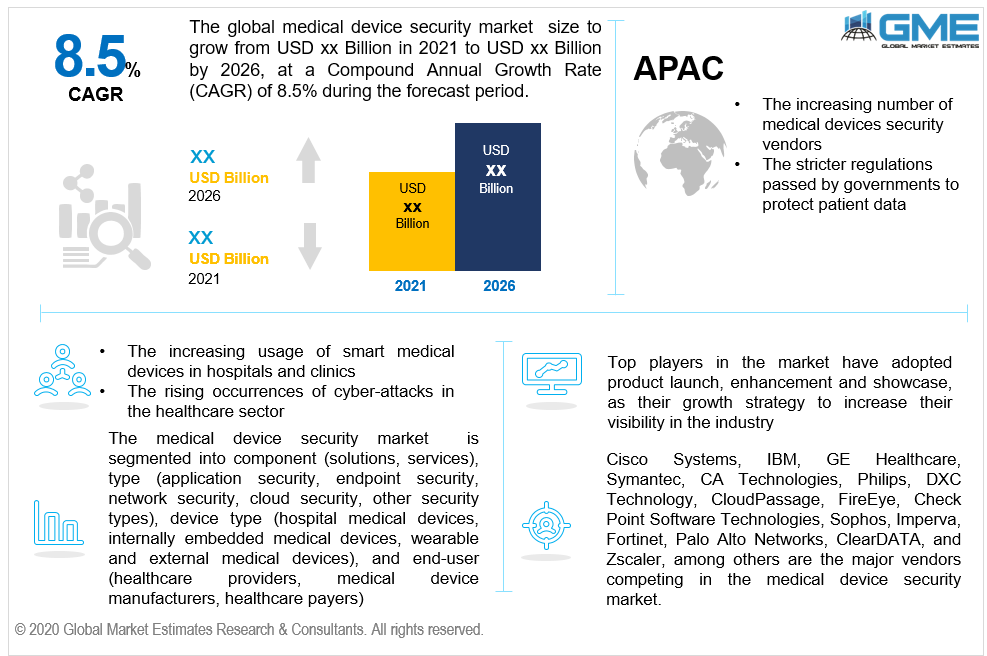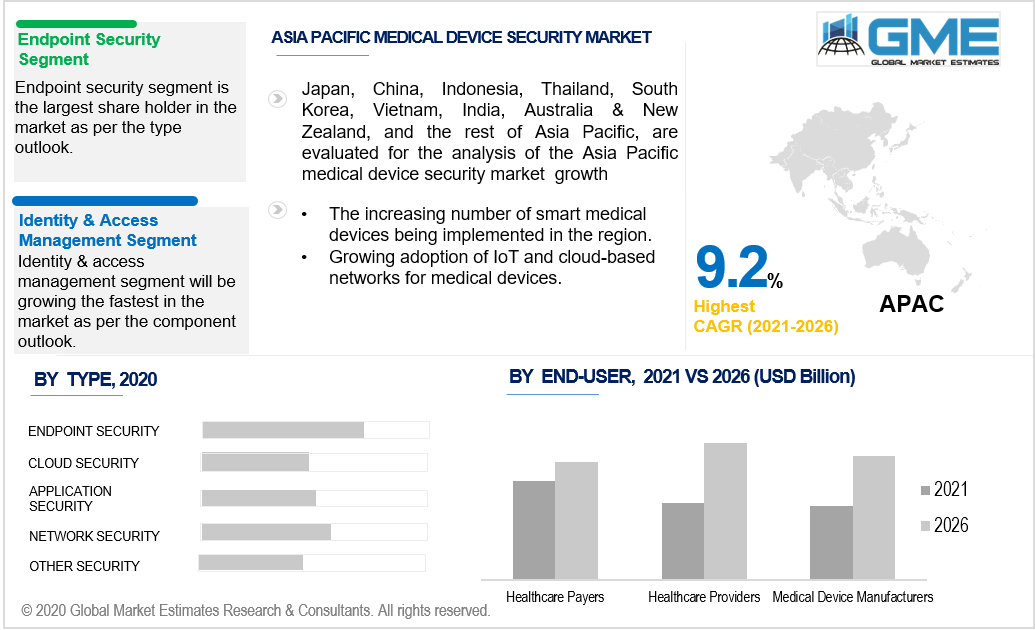
Global Medical Device Security Market Size, Trends, and Analysis- Forecasts To 2026 By Component (Solutions [Identity & Access Management (IAM), Antivirus/Antimalware, Risk & Compliance Management, Encryption, Intrusion Detection System/Intrusion Prevention System (IDS/IPS), Data Loss Prevention (DLP), Disaster Recovery, Distributed Denial of Service (DDoS), Other Solutions (Firewall, Patch Management, Unified Threat Management (UTM), SIEM, and Security & Vulnerability Management], Services [Professional Services, Consulting, Support & Maintenance, Design & Integration, Training and Education Services, Managed Security Services]), By Type (Application Security,Endpoint Security, Network Security, Cloud Security, Other Security Types [Email, Web, and Database Security]), By Device Type (Hospital Medical Devices, Internally Embedded Medical Devices, Wearable and External Medical Devices), By End-User (Healthcare Providers, Medical Device Manufacturers, Healthcare Payers), By Region (North America, Asia Pacific, CSA, Europe, and the Middle East and Africa); End-User Landscape, Company Market Share Analysis & Competitor Analysis
Technological advancements in information technology & communications devices have seen healthcare facilities implement interconnected devices to ensure a smoother experience for patients. Devices like MRI scanners, X-Ray machines, surgical robots, heart monitors, dental devices, among others are being interconnected so that healthcare providers can monitor the patient’s data instantaneously. With such interconnectivity, comes security risks as cyber-attacks have become very common. With various medical devices in the market that can record user’s medical data like blood pressure, ECG, etc. these devices are required to have state-of-the-art security systems to prevent the users’ data from being exploited. This has increased the demand for medical device security solutions among healthcare facilities as hospitals and clinics are responsible for protecting the personal data of their patients. Governments have stepped in to ensure healthcare providers are taking the necessary precautions to protect their patient’s data from cyber-attacks. The growing data privacy concerns within the general public have also forced governments to implement stringent regulations to protect their data. Such regulations and the growing implementation of new technology are the major drivers of the global medical device security market. The market is restricted by the cost of implementing such technology, low investment in healthcare security, and the need for skilled personnel.

The medical device security is segmented into solutions and services as per the component analysis. The solutions segment includes identity & access management, risk management, data loss protection. While the services segment includes professional consulting, services, support & maintenance. The solutions segment is the dominant segment as per thecomponent analysis. Among the solutions segment, identity & access management is the fastest-growing subsegment. The solution offered by medical device security vendors is inclusive of technical expertise, hardware, and software. It is an all-inclusive package for companies that are just implementing medical device security measures.
According to the type, the medical device security market can be segmented as endpoint security, application security, cloud security,network security, and others. Endpoint security has the largest share of the market due to the growing number of medical devices being used in hospitals and clinics combined with practices like BYOD. In recent years, mobiles and personal computers have become essential in hospitals and healthcare facilities. This has risen the risk of online crime such as phishing, spam ware, ransomware, and other malicious attacks. This increased risk factor has made it important for healthcare facilities to secure the devices used by their employees to prevent attacks. The endpoint security protects the devices used by the employees from such attacks making it the dominant market segment.
Based on the device type, the market can be segmented into internally embedded medical devices, hospital medical devices, external medical devices, and wearable. The wearable and external devices segment is the dominant segment due to the growing demand for cheap consumer medical devices in the market. Wearable and external devices are becoming a common occurrence among the general population, increased awareness about health risks and prevention of diseases people are turning to wearable devices as a source of keeping track of their habits. Wearable and external devices are capable of recording various data like heart rates, blood pressure, analyze ECG, and also other biosensor data that can monitor a person's wellbeing. This data is extremely personal and such device manufacturers have to take the necessary steps to prevent their customers from having their information stolen.
Based on the end-user analysis, the market can be segmented into medical device manufacturers, healthcare providers, and healthcare payers. The segment of healthcare provider holds the larger share of the market among the three segments. Healthcare providers like hospitals and clinics use medical extensively, these devices are interconnected with other devices within their facilities. Usually, these facilities are large enough to absorb the costs involved in setting up device security systems. The information stored by them about their patients is sensitive and they are obliged to protect this information. Governments are beginning to implement stringent regulations and laws aimed at protecting patient data making it vital for healthcare providers to have state-of-the-art top-notch medical device security systems in place.

The North American region is the dominant region due to the greater implementation of interconnected medical devices in this region. The stringent regulations by the government are another reason for the dominance of this region in the global medical device security market. The increased market penetration of wearable devices and external medical devices in the region has increased the demand for medical device security vendors. The region also has a large skilled labor force that is capable of creating a state of the art medical device security systems. The increased concerns about data protection have also contributed to the demand for medical device security systems in the region. The APAC regions account for the fastest-growing region. The increasing adoption of smart medical devices has seen this market grow quickly in recent years. The increasing number of cyber-attacks in this region has also seen stricter regulations being made by governments. The growing number of medical device security vendors in the region is another reason for the rapid growth in this region.
IBM, Cisco Systems, GE Healthcare, CA Technologies, Symantec, Philips, CloudPassage, DXC Technology, FireEye, Sophos, Check Point Software Technologies, Imperva, Palo Alto Networks,Fortinet, ClearDATA, and Zscaler, among others,are the majorvendors competing in the medical device security market.
Please note: This is not an exhaustive list of companies profiled in the report.
In 2020, GE Healthcare released the Skeye service that protects healthcare providers from cyber-attacks. This helped the company gain visibility for the product in the market
In 2021, the Palo Alto Networks company expanded its IoT security services to cover healthcare providers as well. This strategy helped the company increase its market presence.
We value your investment and offer free customization with every report to fulfil your exact research needs.
The Global Medical Device Security Market has been studied from the year 2019 till 2026. However, the CAGR provided in the report is from the year 2021 to 2026. The research methodology involved three stages: Desk research, Primary research, and Analysis & Output from the entire research process.

The desk research involved a robust background study which meant referring to paid and unpaid databases to understand the market dynamics; mapping contracts from press releases; identifying the key players in the market, studying their product portfolio, competition level, annual reports/SEC filings & investor presentations; and learning the demand and supply-side analysis for the Medical Device Security Market.

The primary research activity included telephonic conversations with more than 50 tier 1 industry consultants, distributors, and end-use product manufacturers.

Finally, based on the above thorough research process, an in-depth analysis was carried out considering the following aspects: market attractiveness, current & future market trends, market share analysis, SWOT analysis of the company and customer analytics.

Tailor made solutions just for you
80% of our clients seek made-to-order reports. How do you want us to tailor yours?
OUR CLIENTS